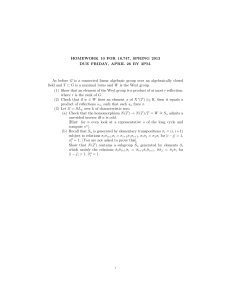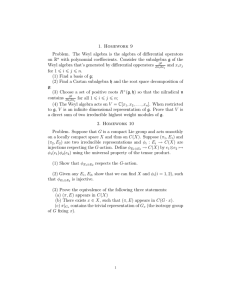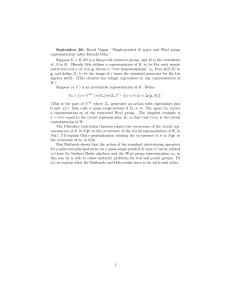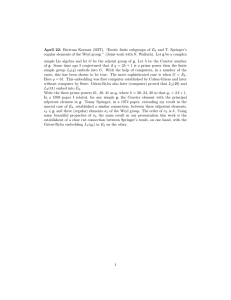VARIATIONAL CHARACTERIZATION OF A SUM OF CONSECUTIVE EIGENVALUES; GENERALIZATION OF
advertisement
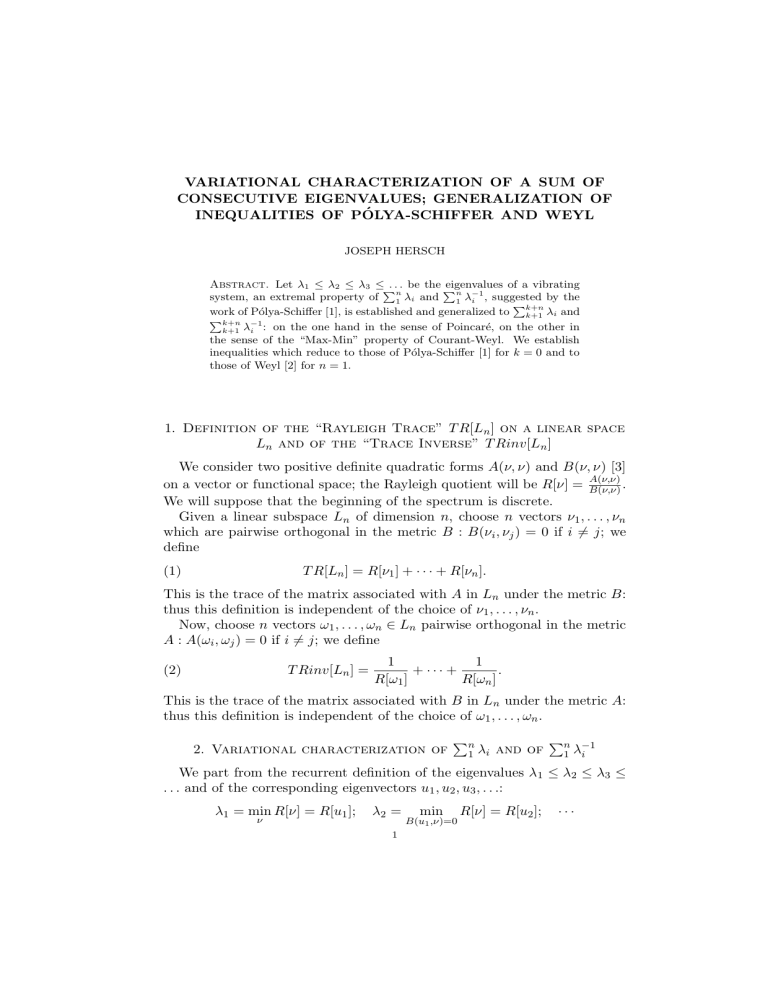
VARIATIONAL CHARACTERIZATION OF A SUM OF CONSECUTIVE EIGENVALUES; GENERALIZATION OF INEQUALITIES OF PÓLYA-SCHIFFER AND WEYL JOSEPH HERSCH Abstract. Let λ1 ≤ λ2 ≤ λ3 ≤P . . . be the P eigenvalues of a vibrating n −1 system, an extremal property of n λ and by the i 1 1 λi , suggested P work of Pólya-Schiffer [1], is established and generalized to k+n k+1 λi and Pk+n −1 λ : on the one hand in the sense of Poincaré, on the other in k+1 i the sense of the “Max-Min” property of Courant-Weyl. We establish inequalities which reduce to those of Pólya-Schiffer [1] for k = 0 and to those of Weyl [2] for n = 1. 1. Definition of the “Rayleigh Trace” T R[Ln ] on a linear space Ln and of the “Trace Inverse” T Rinv[Ln ] We consider two positive definite quadratic forms A(ν, ν) and B(ν, ν) [3] A(ν,ν) on a vector or functional space; the Rayleigh quotient will be R[ν] = B(ν,ν) . We will suppose that the beginning of the spectrum is discrete. Given a linear subspace Ln of dimension n, choose n vectors ν1 , . . . , νn which are pairwise orthogonal in the metric B : B(νi , νj ) = 0 if i 6= j; we define (1) T R[Ln ] = R[ν1 ] + · · · + R[νn ]. This is the trace of the matrix associated with A in Ln under the metric B: thus this definition is independent of the choice of ν1 , . . . , νn . Now, choose n vectors ω1 , . . . , ωn ∈ Ln pairwise orthogonal in the metric A : A(ωi , ωj ) = 0 if i 6= j; we define (2) T Rinv[Ln ] = 1 1 + ··· + . R[ω1 ] R[ωn ] This is the trace of the matrix associated with B in Ln under the metric A: thus this definition is independent of the choice of ω1 , . . . , ωn . 2. Variational characterization of Pn 1 λi and of Pn 1 λ−1 i We part from the recurrent definition of the eigenvalues λ1 ≤ λ2 ≤ λ3 ≤ . . . and of the corresponding eigenvectors u1 , u2 , u3 , . . .: λ1 = min R[ν] = R[u1 ]; ν λ2 = 1 min B(u1 ,ν)=0 R[ν] = R[u2 ]; ··· 2 JOSEPH HERSCH For any n ≥ 1, (3) λ 1 + λ2 + · · · + λ n = min choice of Ln T R[Ln ]. In effect, there exists in all Ln : a vector νn which is B-orthogonal to u1 , . . . , un−1 , so R[νn ] ≥ λn ; a vector νn−1 which is B-orthogonal to u1 , . . . , un−2 and to νn , so R[νn−1 ] ≥ λn−1 ; .. . a vector ν1 which is B-orthogonal to νn , . . . , ν2 , and R[ν1 ] ≥ λ1 . In the sum: λ1 + · · · + λn ≤ T R[Ln ]. In addition, T R[L(u1 , . . . , un )] = λ1 + · · · + λn ; (3) follows. Similarly, 1 1 + ··· + = max T Rinv[Ln ]. λ1 λn choice of Ln (4) 3. Recurrent characterization of (5) k+n X λi = k+1 Pk+n k+1 λi and min choice of Ln B-orthogonal to L(u1 ,...,uk ) Pk+n k+1 λ−1 i : T R[Ln ]. In effect: in all tel Ln there exists a vector νk+n B-orthogonal to u1 , . . . , uk+n−1 , therefore R[νk+n ] ≥ λk+n ; etc. (6) k+n X k+1 1 = λi choice of Ln max A-orthogonal to L(u1 ,...,uk ) 4. Direct characterizations of Pk+n k+1 T Rinv[Ln ]. λi and 4.1. Extremal property “in the style of Poincaré”. (7) k+n X k+1 (8) k+n X k+1 λi = min max choice of Lk+n choice of Ln ⊂Lk+n Pk+n k+1 T R[Ln ]; 1 = max min T Rinv[Ln ]. λi choice of Lk+n choice of Ln ⊂Lk+n λ−1 i VARIATIONAL CHARACTERIZATION OF A SUM OF CONSECUTIVE EIGENVALUES3 4.2. Extremal property “in the style of Courant-Weyl”. k+n X (9) λi = k+1 k+n X (10) k+1 max min choice of Lk choice of Ln B-orthogonal to Lk T R[Ln ]; 1 = min max T Rinv[Ln ]. λi choice of Lk choice of Ln A-orthogonal to Lk 5. Generalized inequalities of Pólya-Schiffer [1] and of Weyl [2] 5.1. Schrödinger-type equation. ∇u + [λ − W (x, y, z)]u = 0 with certain fixed conditions on limits; RRR D(ν) + W ν 2 dτ (W ) RRR R [ν] = , ν 2 dτ where dτ is the volume element and D(ν) is the Dirichlet integral. n X [(W1 +W2 )/2] (W2 ) (W1 ) )≤0 − 2λk1 +k + λk2 +i (λk1 +i 2 +i (11) (k1 ≥ 0, k2 ≥ 0, n ≥ 1). i=1 f (x, y, z) = (W1 + Proof. Denote by u e1 , u e2 , u e3 , . . . the eigenfunctions of W (W ) (W ) W2 )/2; in L(e u1 , . . . , u ek1 +k2 +n ), there is an Ln orthogonal to both L(u1 1 , . . . , uk1 1 ) (W2 ) and L(u1 kX 1 +n k1 +1 (W1 ) λi + (W ) , . . . , uk2 2 ); thus, under the conditions of paragraph 3, kX 2 +n k2 +1 (W2 ) λi f ≤ T R(W1 ) [Ln ]+T R(W2 ) [Ln ] = 2T R(W ) [Ln ] ≤ 2 k1 +k 2 +n X k1 +k2 +1 For k1 = k2 = 0, we have a convex inequality of the type of Pólya-Schiffer [1]; for n = 1, we have an inequality of the type of Weyl [2]. 5.2. Inhomogeneous vibrating system. L[u] − λρ(x, y, . . .)u = 0 with certain fixed conditions on the boundary, and with density ρ ≥ 0. (Here L is a self-adjoint linear differential operator). The Rayleigh quotient is R R R(ρ) [ν] = νL[ν]dτ / ρν 2 dτ . ! n X 1 1 1 (12) + · · · + (ρ ) − (ρ +···+ρ ) ≥ 0. (ρ ) λk11+1 λkNN+i λk11+···+kNN+i i=1 For N = 2 and k1 = k2 = 0, this gives a convex inequality of the type of Pólya-Schiffer [1]; for n = 1, this gives an inequality of the type of Weyl [2]. If k1 = k2 = . . . = kN = 0 and n = ∞, there is equality; we will return to this. f) (W λi . 4 JOSEPH HERSCH References [1] G. Pólya and M. Schiffer, J. Anal. Math., 3 (2nd part), 1953-1954, p. 245345, in particular p. 286-290. [2] H. Weyl, Math. Ann., 71, 1912, p. 441-479, in particular p. 445; also see J. Hersch, Propriétés de convexité du type de Weyl pour des problèmes de vibration et d’équilibre, to appear in Z.A.M.P. [3] We always suppose B is positive definite; the relations (1), (3), (5), (7), (9), (11) remain valid if A is indefinite with only finitely many negative eigenvalues. DRL 3E3A, University of Pennsylvania E-mail address: shonkwil@math.upenn.edu
